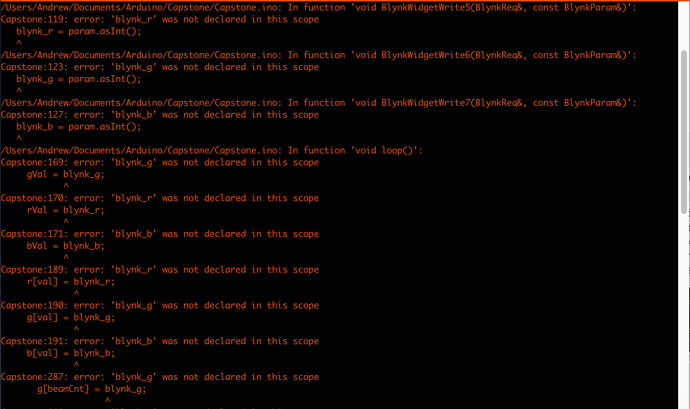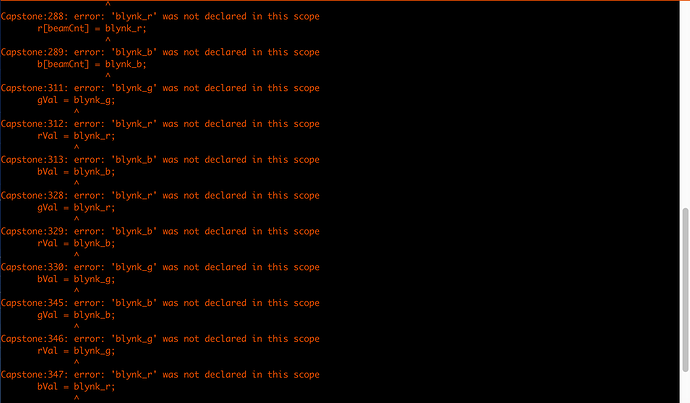I took screenshots of the errors I’m getting in Arduino. The code is below the screenshots (sorry if the formatting is bad. I’m new to this site and the code is pretty long). The error comes at the line: bVal = blynk_r;
Anyone know what they mean and the solution(s)? My file name is Capstone:
#include <Blynk.h>
#include <Adafruit_DotStar.h>
#include <SPI.h>
#include <ESP8266WiFi.h>
#include <ESP8266WiFiMulti.h>
// constants
#define NUMPIXELS 60 // number LEDs on the strip
#define ESP8266_LED 5 // ESP8266 on-board LED on port 5
#define MINIBAR_LEN_TREB 7 // len of small bar in mode 3
#define MINIBAR_LEN_BASS 30 // len of mid bar in mode 3
#define MINIBAR_LEN_MIDL 15 // len of mid bar in mode 3
#define DATAPIN 2 // GPIO2 - MOSI
#define CLOCKPIN 4 // GPIO4 - CLK
#define IP_ADDR “74.101.17.188” // IP address of pc running Processing app
#define SSID_NAME “584N6” // SSID of the network in use
#define SSID_PW “JX7TFN36GRPKXVCH” // password to the network in use
// WiFi
ESP8266WiFiMulti WiFiMulti;
// Use above defined pins for DATA and CLK
Adafruit_DotStar strip = Adafruit_DotStar(NUMPIXELS, DATAPIN, CLOCKPIN);
// Use hardware SPI (DATA-13, SCLK-SCL)
//Adafruit_DotStar strip = Adafruit_DotStar(NUMPIXELS);
// You should get Auth Token in the Blynk App. // Go to the Project Settings (nut icon).
char auth = “41ca952815c3452481585b2b8ef6f0bc”;
// global variables
bool setupFailed = false; // flag for WiFi setup. if failed, blink onboard LED
WiFiClient client; // create TCP connection
byte val = 0; // val received from Processing app (beat in val bin)
// LED controlling variables
unsigned int r[NUMPIXELS] = {0}; // each index holds the R, G, or B value
unsigned int g[NUMPIXELS] = {0}; // of the LED with that index ranging
unsigned int b[NUMPIXELS] = {0}; // from 0 - 255
int heads[NUMPIXELS] = {-1}; // array holding the heads and tails values
int tails[NUMPIXELS] = {-1}; // of the “beams” that go across the LED strip
int beamCnt = 0;
int beamDelay = 0; // counter that increments and every…
int beamPropDelay = 4; // …beamPropDelay it updates the beam
int beamLen = -7; // length of beam in LEDs
// Blynk variables
int customize, modeSel; // flags int blynk_r, blynk_g, blynk_b; // r,g,b
void setup()
{
// set up onboard LED mode
pinMode(ESP8266_LED, OUTPUT);
// set up Blynk
Blynk.begin(auth, SSID_NAME, SSID_PW);
// set up WiFi connection to PC
const uint16_t port = 5204;
const char * host = IP_ADDR; // ip or dns
Serial.begin(115200);
delay(10);
// We start by connecting to a WiFi network
WiFiMulti.addAP(SSID_NAME, IP_ADDR);
Serial.println();
Serial.println();
Serial.print(“Wait for WiFi… “);
while(WiFiMulti.run() != WL_CONNECTED) {
Serial.print(”.”);
delay(500);
}
Serial.println(“”);
Serial.println(“WiFi connected”);
Serial.println("IP address: ");
Serial.println(WiFi.localIP());
delay(500);
Serial.print("connecting to ");
Serial.println(host);
if (!client.connect(host, port)) {
Serial.println(“connection failed, restart system”);
setupFailed = true;;
}
strip.begin();
strip.show();
// random seed
randomSeed(0);
}
// Blynk functions for virtual pins BLYNK_WRITE(V0)
{
modeSel = 0; }
BLYNK_WRITE(V1)
{
modeSel = 1; }
BLYNK_WRITE(V2)
{
modeSel = 2; }
BLYNK_WRITE(V3)
{
modeSel = 3; }
BLYNK_WRITE(V4)
{
customize = param.asInt(); }
BLYNK_WRITE(V5)
{
blynk_r = param.asInt(); }
BLYNK_WRITE(V6)
{
blynk_g = param.asInt(); }
BLYNK_WRITE(V7)
{
blynk_b = param.asInt(); }
BLYNK_WRITE(V8)
{
beamPropDelay = param.asInt(); }
BLYNK_READ(V9)
{
Blynk.virtualWrite(9, modeSel); }
void loop() {
int i; // counter used for misc purposes
int gVal, rVal, bVal; // temporary holder variables for RGB values
// blink onboard LED if wifi failed
if (setupFailed == true)
{
digitalWrite(ESP8266_LED, HIGH);
delay(1000);
digitalWrite(ESP8266_LED, LOW);
delay(1000);
return;
}
Blynk.run(); // Initiates Blynk
if (client.available())
{ // if data is availble to read
val = client.read();
//////////////////// mode 0 ////////////////////
if ( modeSel == 0) // bar flash mode
{
if (!customize) // custom colors
{
gVal = random(0x100);
rVal = random(0x100);
bVal = random(0x100);
}
else // use sliders on Blynk app to determine color
{
gVal = blynk_g;
rVal = blynk_r;
bVal = blynk_b;
}
if (val == 10) // detecting == bin2 (71 < val < 86 Hz )
{
for ( i = 0; i < NUMPIXELS; i++)
{
r[i] = rVal;
g[i] = gVal;
b[i] = bVal;
}
}
}
//////////////////// mode 1 ////////////////////
else if ( modeSel == 1 )
{ // spectrum mode (sub bass, bass, midrange, high mids, high freq)
if (customize)
{
r[val] = blynk_r;
g[val] = blynk_g;
b[val] = blynk_b;
} else {
if (val < 5)
{ // red
r[val] = 0xFF;
g[val] = 0;
b[val] = 0;
}
else if (val < 10)
{ // orange
r[val] = 0xFF;
g[val] = 0xA5;
b[val] = 0;
}
else if (val < 15)
{ // yellow
r[val] = 0xFF;
g[val] = 0xFF;
b[val] = 0;
}
else if (val < 20)
{ // chartreuse
r[val] = 0x7F;
g[val] = 0xFF;
b[val] = 0;
}
else if (val < 25)
{ // green
r[val] = 0;
g[val] = 0x80;
b[val] = 0;
}
else if (val < 30)
{ // spring
r[val] = 0;
g[val] = 0xE6;
b[val] = 0x73;
}
else if (val < 35)
{ // cyan
r[val] = 0;
g[val] = 0xFF;
b[val] = 0xFF;
}
else if (val < 40)
{ // azure
r[val] = 0xF0;
g[val] = 0xFF;
b[val] = 0xFF;
}
else if (val < 45)
{ // blue
r[val] = 0;
g[val] = 0;
b[val] = 0xFF;
}
else if (val < 50)
{ // violet
r[val] = 0xEE;
g[val] = 0x82;
b[val] = 0xEE;
}
else if (val < 55)
{ // magenta
r[val] = 0xFF;
g[val] = 0x00;
b[val] = 0xFF;
}
else
{ // rose
r[val] = 0xFF;
g[val] = 0;
b[val] = 0xFF;
}
}
}
//////////////////// mode 2 ////////////////////
else if ( modeSel == 2 )
{
if (val == 17 )
{ // trigger the beam
if (beamCnt >= NUMPIXELS)
beamCnt = 0;
heads[beamCnt] = 0;
tails[beamCnt] = beamLen;
if (!customize) // every beam gets a random color
{
r[beamCnt] = random(0x100);
g[beamCnt] = random(0x100);
b[beamCnt] = random(0x100);
}
else
{ // using zeRGBa on Blynk app to determine color
g[beamCnt] = blynk_g;
r[beamCnt] = blynk_r;
b[beamCnt] = blynk_b;
}
beamCnt++;
}
}
//////////////////// mode 3 ////////////////////
else if ( modeSel == 3 )
{ // random small bars (bass, mid, treble)
// random colors if custom button not pressed on Blynk app
if (!customize)
{
gVal = random(0x100);
rVal = random(0x100);
bVal = random(0x100);
}
// determine location of bass bar
i = random(60 - MINIBAR_LEN_BASS);
if (val == 10)
{
if (customize)
{
gVal = blynk_g;
rVal = blynk_r;
bVal = blynk_b;
}
for (int j = i ; j < i + MINIBAR_LEN_BASS; j++)
{
r[j] = rVal;
g[j] = gVal;
b[j] = bVal;
}
}
// determine location of mid bar
i = random(60 - MINIBAR_LEN_MIDL);
if (val == 17)
{
if (customize)
{
gVal = blynk_r;
rVal = blynk_b;
bVal = blynk_g;
}
for (int j = i ; j < i + MINIBAR_LEN_MIDL; j++)
{
r[j] = rVal;
g[j] = gVal;
b[j] = bVal;
}
}
// determine location of treble bar
i = random(60 - MINIBAR_LEN_TREB);
if (val == 54)
{
if (customize)
{
gVal = blynk_b;
rVal = blynk_g;
bVal = blynk_r;
}
for (int j = i ; j < i + MINIBAR_LEN_TREB; j++)
{
r[j] = rVal;
g[j] = gVal;
b[j] = bVal;
}
}
}
else if ( modeSel == 4 )
{
for (i = 0; i < NUMPIXELS; i++)
{
r[i] = val;
g[i] = val;
b[i] = val;
strip.setPixelColor(i, g[i], r[i], b[i]);
}
}
}
loop
} }
// mode 2 - beam propagation
// update head location every beamPropDelay // to control beam propagation speed
if (beamDelay++ % beamPropDelay == 0)
{
for (i = 0; i < NUMPIXELS; i++)
{
strip.setPixelColor(heads[i], g[i], r[i], b[i]);
strip.setPixelColor(tails[i], 0);
if (heads[i] >= 0)
{
if ( ++heads[i] >= NUMPIXELS) // reset head
heads[i] = -1;
}
if (tails[i] >= beamLen)
{
if ( ++tails[i] >= NUMPIXELS ) // reset tail
tails[i] = beamLen - 1;
}
}
}
// dimming, all modes except beam (mode 2)
if ( modeSel == 0 || modeSel == 1 || modeSel == 3 )
{
for ( i = 0; i < NUMPIXELS; i++ )
{
if (g[i] > 0)
g[i] /= 1.04;
if (r[i] > 0)
r[i] /= 1.04;
if (b[i] > 0)
b[i] /= 1.04;
strip.setPixelColor(i, g[i], r[i], b[i]);
}
}
strip.show();
delay(5); // give uController time to maintain behind the scenes tasks
}


